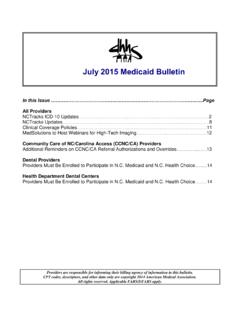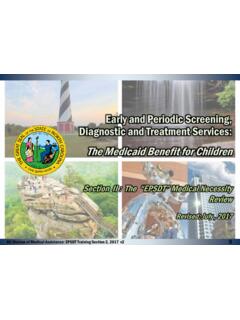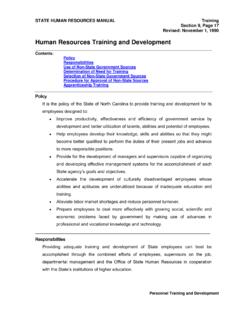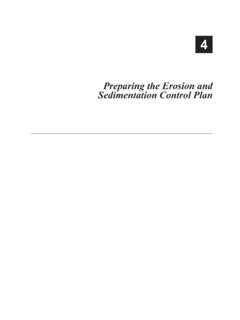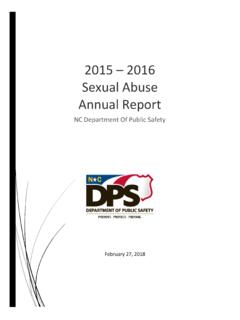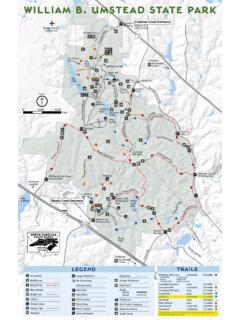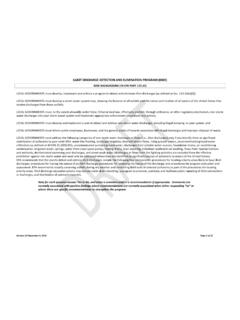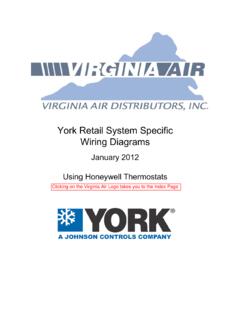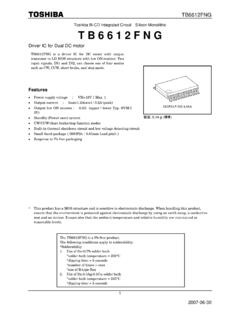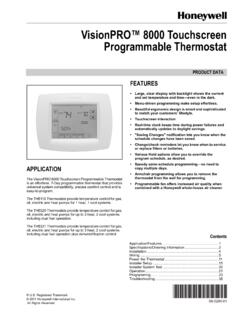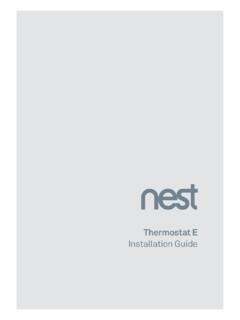Transcription of STATE OF NORTH CAROLINA
1 STATE OF NORTH CAROLINA . DEPARTMENT OF ADMINISTRATION. STATE CONSTRUCTION OFFICE. ELECTRICAL. GUIDELINES AND POLICIES. 2020. Electrical Guidelines and Policies - 2020. The following guidelines and policies are established to aid the Designer during design development and specification writing. Contents herein are not to be included in Designer's specification by reproduction but shall be used as a guide only. Variances of these guidelines and policies shall be discussed with the STATE Construction Office prior to submitting design to alleviate possible extra work on the Designer's part. Projects (SD, DD, and associated CD documents) submitted by January 31, 2021 will continue to be reviewed per the 2017 electrical guidelines unless the designers' request review per the 2020 electrical guidelines. The intent is that projects starting the review process January 31, 2021 and before will continue being reviewed per the 2017 guidelines. These guidelines become effective for new SD, DD, and associated CD submittals February 1, 2021 and after.
2 The following replaces the Electrical Guidelines and Policies --2017 in its entirety. -1- Electrical Guidelines and Policies - 2020. TABLE OF CONTENTS. 00 00 01 SCOPE .. 4. 26 01 00 RECOGNIZED STANDARDS .. 4. 26 01 00 BASIC ELECTRICAL REQUIREMENTS .. 5. 26 02 05 DIVISION OF WORK .. 8. 26 05 00 EXISTING ELECTRICAL CONDITIONS ENCOUNTERED DURING REMODELING, ADDITIONS, OR. ALTERATIONS .. 10. 26 05 13 MEDIUM-VOLTAGE CABLE .. 10. 26 05 19 BUILDING WIRE AND 13. 26 05 26 GROUNDING AND BONDING .. 15. 26 05 29 SUPPORTING 16. 26 05 33 CONDUIT .. 17. 26 05 43 DUCT 19. 26 05 53 ELECTRICAL IDENTIFICATION .. 20. 26 08 00 ELECTRICAL TESTING AND COMMISSIONING .. 21. 26 11 00 UNIT SUBSTATIONS .. 23. 26 12 19 PAD MOUNTED SERVICE TRANSFORMERS .. 24. 26 18 00 LOADBREAK INTERRUPTER AND PADMOUNT SECTIONALIZING SWITCHES .. 26. 26 18 01 OIL INTERRUPTER SWITCHES .. 26. 26 22 00 DRY TYPE TRANSFORMERS .. 27. 26 24 13 DISTRIBUTION SWITCHBOARDS (600 Volt) .. 27. 26 24 16 PANELBOARDS.
3 28. 26 24 19 MOTOR CONTROL 29. 26 27 26 WIRING DEVICES .. 30. 26 28 13 FUSES (600 VOLTS OR LESS) .. 31. 26 28 16 ENCLOSED 31. 26 32 13 PACKAGED ENGINE GENERATOR SYSTEMS .. 32. 26 33 00 STATIC EMERGENCY POWER SUPPLIES (Central Inverter Systems).. 38. 26 36 00 AUTOMATIC TRANSFER SWITCHES .. 38. 26 41 00 LIGHTNING PROTECTION 40. 26 43 13 SURGE PROTECTIVE DEVICES (SPD) .. 41. 26 51 00 INTERIOR 41. 26 56 00 SITE and EXTERIOR LIGHTING .. 46. 27 05 00 TELECOMMUNICATIONS AND INFORMATION TECHNOLOGY .. 46. 28 31 13 FIRE ALARM SYSTEMS .. 47. 33 71 00 OVERHEAD POWER DISTRIBUTION .. 47. -2- Electrical Guidelines and Policies - 2020. APPENDIX PAGE NO. Minimum Standards for Residential Projects .. 49. DETAILS. Lighting Life Cycle Cost Analysis (LCCA) .. E-00. Generator System Wiring .. E-1. Emergency Generator Outside the Building - 100% E-2. Emergency Generator Outside the Building - Not 100% E-3. Emergency Generator Inside the Building - 100% E-4. Emergency Generator Inside the Building - Not 100% E-5.
4 Typical Panelboard Schedule .. E-6. Typical Grounding Detail for Three Phase Pad Mounted Transformers .. E-7. Load Tabulation Breakdown .. E-8. Working Clearance for Electrical Equipment ..E-9. Dedicated Space for Electrical Equipment .. E-10. Report of Primary Voltage Cable Testing (Standard Form).. E-11. Fire Pump Controller Grounding Detail .. E-12. Service Equipment Grounding Detail .. E-13. Dry Type Transformer Grounding Detail .. E-14. Receptacle Grounding Detail .. E-15. Lighting Fixture Mounting Detail .. E-16. Typical Exterior Pole Base Detail .. E-17. Electrical Equipment Connection .. E-18. -3- Electrical Guidelines and Policies - 2020. 00 00 01 SCOPE. 1. These Guidelines and Policies apply to all STATE Government funded projects on STATE owned property, Community College projects, except for Code Only projects and certain projects exempted by legislation or other approved policies. Other project delivery methods, Construction Manager at Risk (CMR), Design Build, Public Private Partnership (P3) may have other specific requirements.
5 Refer to NC STATE Construction Manual. 2. The designer remains responsible to coordinate with owner for any specific or special requirements. 26 01 00 RECOGNIZED STANDARDS. a) AEIC (American Association of Edison Illuminating Companies). b) ANSI (American National Standards Institute for Fluorescent Ballasts). c) ASHRAE/IES ( energy conservation code). d) ASTM (American Society for Testing and Materials). e) BOCA (Building Officials Code Administrators). f) DOE United States Department of Energy g) EPA Environmental Protection Agency h) EPAct (Energy Policy Act of the US Department of Energy). i) ICBO (International Conference of Building Officials). j) ICC (International Code Council). k) ICEA (Insulated Cable Engineers Association). l) IEEE (Institute of Electrical and Electronic Engineers). m) IES (Illuminating Engineering Society). n) NCAC ( NORTH CAROLINA Administrative Code). o) NCCM STATE Construction Manual p) NCBC ( Building Code), also NCSBC ( STATE Building Code).
6 Q) NCBCC ( Building Code Council). r) NEC (National Electrical Code) as amended by NC Building Code Council s) NECA (National Electrical Contractor Association). t) NEIS (National Electrical Installation Standards). -4- Electrical Guidelines and Policies - 2020. u) NEMA (National Electrical Manufacturers Association). v) NESC (National Electrical Safety Code). w) NETA (International Electrical Testing Association). x) NFPA (National Fire Protection Association). y) OSHA (Occupational Safety and Health Administration). z) TCLP (Toxicity Characteristic Leaching Procedure). aa) UL (Underwriters' Laboratories Inc.). 26 01 00 BASIC ELECTRICAL REQUIREMENTS. 1. Specifications for electrical work shall clearly indicate the responsibility of the Electrical Contractor to notify the STATE Electrical Inspector with Department of Administration; for STATE - owned projects, and to notify the local inspectors; for community college & county owned buildings, to schedule required inspections.
7 2. Non-Appropriated Funds Projects, such as: Privately Funded Projects on STATE Land, or Privately Funded Projects on Private Land that will be maintained by the STATE , or Privately Funded Projects on Community College Land shall be designed to meet or exceed requirements issued by this office including: Electrical Guidelines and Policies, the Fire Alarm Guidelines and Policies, the STATE Construction Office Manual. Adherence to these publications is expected. Please see STATE Construction Manual, Table 500 for the non- appropriated funds projects. 3. For review submittals to the SCO office, all documents inclusive of electrical drawings and specifications shall be sealed by the Design Engineer of Record registered in the STATE of NORTH CAROLINA . Bid documents must be sealed, signed, and dated. Professional seal is also required on plans for the design of the special systems, such as theatrical stage lighting, audio/video, access control, lightning protection, and the like.
8 Provide engineering firm license number on drawings Per 21 NCAC 4. An electrical symbol schedule and legend shall appear on the first sheet of the electrical drawings. The electrical symbols shown on the bid documents shall consist of standard design symbols. To clarify, standard symbols can be found in current editions of the Architectural Graphic Standards, the American Electricians' Handbook, and in the IEEE. Standards. Fire Alarm and life Safety symbols should be based on symbols defined in the American National Standard NECA 100. 5. On the electrical drawings, the Designer shall include a Load Tabulation Breakdown in KVA. rating for the existing peak demand load, if any, the new connected load, and demand load, and the diversity factor. Perform the calculation as required by NEC Article 220. Where two or more non-coincident loads will not be used simultaneously, the largest load only shall be calculated. (See Appendix, Sheet E-8). 6. Special attention is directed to General Statute 133-3 (Specifications to Carry Competitive Items, Substitution of Materials) for strict adherence thereto (for all equipment where available).
9 See the procedure provided on the SCO web site regarding this issue. -5- Electrical Guidelines and Policies - 2020. 7. The Design Engineer shall provide short-circuit coordinated protection where required by NEC. It is the Engineer's responsibility to make sure the system is fully coordinated and properly protected against short circuit, overload, and ground fault. During design of new installations where preliminary calculated fault current exceeds 80% of equipment withstand rating, the Design Engineer shall select the next higher standard rating. For existing installations, Design Engineer shall evaluate the existing equipment withstanding rating and coordinate with STATE Construction Office (SCO) for fault reduction measures if needed. In addition to required performance for projects involving Emergency Systems (Article 700), Health Care Facilities (Article 517) and Critical Operations Power Systems (Article 708), any SCO projects which involve the use of protective relays, adjustable trip circuit breakers, and main fuses shall also require completion of a coordination study.
10 This includes SCO projects involving modifications to existing equipment. These studies shall be performed in accordance with recommendation of the IEEE standards and NEC. At the time of construction document submittal, where NEC. Article 240 arc energy reduction provisions apply (or upon request by the SCO), the Engineer's basis-of-design shall clearly document the Engineer's selected arc energy reduction method. After the Design Engineer's approval of the vendor shop drawings a final coordination study inclusive of arc flash hazard analysis based on the protective devices provided for the project should be reviewed, approved, and dated by the Engineer of Record. If requested, the study shall be submitted to SCO. 8. In accordance with General Statutes 66-23 thru 25, the project documents shall require all electrical materials, devices, appliances, and equipment to be evaluated for safety and suitability for intended use. The project documents shall specifically refer to the current List for third-party Agencies Accredited by the NCBCC to Label Electrical and Mechanical Equipment, as the basis for evaluation with the applicable nationally recognized standards.

